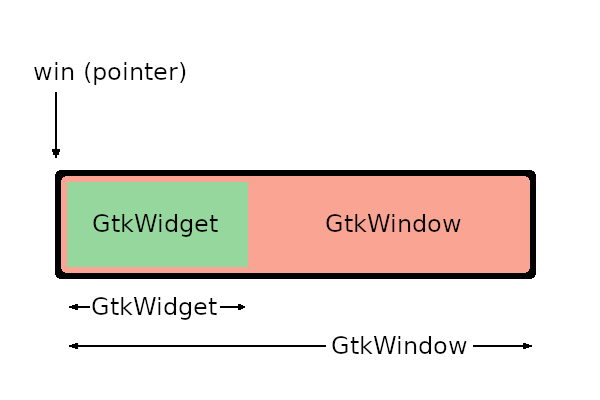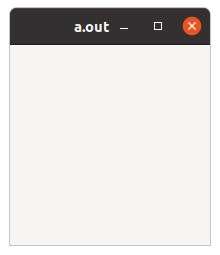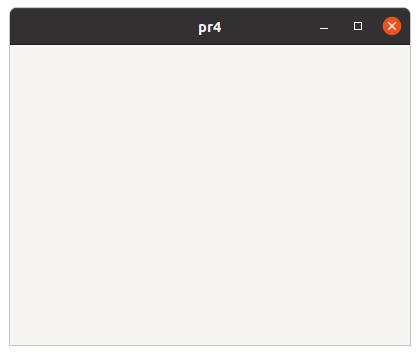GtkApplication and GtkApplicationWindow
GtkApplication
GtkApplication and g_application_run
People write programming codes to make an application. What are applications? Applications are software that runs using libraries, which are the OS, frameworks and so on. In GTK 4 programming, the GtkApplication is a program (or executable) that runs using Gtk libraries.
The basic way to write a GtkApplication is as follows.
- Create a GtkApplication instance.
- Run the application.
That’s all. Very simple. The following is the C code representing the scenario above.
#include <gtk/gtk.h>
int
main (int argc, char **argv) {
GtkApplication *app;
int stat;
app = gtk_application_new ("com.github.ToshioCP.pr1", G_APPLICATION_DEFAULT_FLAGS);
stat =g_application_run (G_APPLICATION (app), argc, argv);
g_object_unref (app);
return stat;
}The first line says that this program includes the header files of
the Gtk libraries. The function main is a startup function
in C language. The variable app is defined as a pointer to
a GtkApplication instance. The function gtk_application_new
creates a GtkApplication instance and returns a pointer to the instance.
The GtkApplication instance is a C structure data in which the
information of the application is stored. The arguments will be
explained later. The function g_application_run runs an
application that the instance defined. (We often say that the function
runs app. Actually, app is not an application
but a pointer to the instance of the application. However, it is simple
and short, and probably no confusion occurs.)
Here I used the word instance. Instance, class and
object are terminologies in Object Oriented Programming. I use these
words in the same way. But, I will often use “object” instead of
“instance” in this tutorial. That means “object” and “instance” is the
same. Object is a bit ambiguous word. In a broad sense, object has wider
meaning than instance. So, readers should be careful of the contexts to
find the meaning of “object”. In many cases, object and instance are
interchangeable.
The function gtk_application_new has two parameters.
Application ID (com.github.ToshioCP.pr1). It is used to distinguish applications by the system. The format is reverse-DNS. See GNOME Developer Documentation – Application ID for further information.
Application flag (G_APPLICATION_DEFAULT_FLAGS). If the application runs without any arguments, the flag is G_APPLICATION_DEFAULT_FLAGS. Otherwise, you need other flags. See GIO API reference for further information.
Notice: If your GLib-2.0 version is older than 2.74, use
G_APPLICATION_FLAGS_NONE instead of
G_APPLICATION_DEFAULT_FLAGS. It is an old flag replaced by
G_APPLICATION_DEFAULT_FLAGS and deprecated since version
2.74.
To compile this, run the following command. The string
pr1.c is the filename of the C source code above.
If you’ve downloaded this repository, you don’t need to create the
file. There’s the same file at src/misc/pr1.c in your local
repository. All the example codes are under the src
directory as well.
$ gcc `pkg-config --cflags gtk4` pr1.c `pkg-config --libs gtk4`The C compiler gcc generates an executable file, a.out.
Let’s run it.
$ ./a.out
(a.out:5084): GLib-GIO-WARNING **: 09:52:04.236: Your application does not implement
g_application_activate() and has no handlers connected to the 'activate' signal.
It should do one of these.
$Oh, it just produces an error message. This error message shows that the GtkApplication object ran, without a doubt. Now, let’s think about what this message means.
Signals
The message tells us that:
- The application doesn’t implement
g_application_activate(), - It has no handlers connected to the “activate” signal, and
- You will need to solve at least one of these.
These two problems are related to signals. So, I will explain that first.
A signal is emitted when something happens. For example, a window is created, a window is destroyed and so on. The signal “activate” is emitted when the application is activated. (Activated is a bit different from started, but you can think of them both as almost the same so far.) If the signal is connected to a function, which is called a signal handler or simply handler, then the function is invoked when the signal is emitted.
The flow is like this:
- Something happens.
- If it’s related to a certain signal, then the signal is emitted.
- If the signal has been connected to a handler in advance, then the handler is invoked.
Signals are defined in objects. For example, the “activate” signal belongs to the GApplication object, which is a parent object of GtkApplication object.
The GApplication object is a child object of the GObject object. GObject is the top object in the hierarchy of all the objects.
GObject -- GApplication -- GtkApplication
<---parent --->childA child object inherits signals, functions, properties and so on from its parent object. So, GtkApplication also has the “activate” signal.
Now we can solve the problem in pr1.c. We need to
connect the “activate” signal to a handler. We use a function
g_signal_connect which connects a signal to a handler.
#include <gtk/gtk.h>
static void
app_activate (GApplication *app, gpointer *user_data) {
g_print ("GtkApplication is activated.\n");
}
int
main (int argc, char **argv) {
GtkApplication *app;
int stat;
app = gtk_application_new ("com.github.ToshioCP.pr2", G_APPLICATION_DEFAULT_FLAGS);
g_signal_connect (app, "activate", G_CALLBACK (app_activate), NULL);
stat =g_application_run (G_APPLICATION (app), argc, argv);
g_object_unref (app);
return stat;
}First, we define the handler app_activate which simply
displays a message. The function g_print is defined in GLib
and it’s like a printf in the C standard library. In the function
main, we add g_signal_connect before
g_application_run. The function
g_signal_connect has four arguments.
- An instance to which the signal belongs.
- The name of the signal.
- A handler function (also called callback), which needs to be casted
by
G_CALLBACK. - Data to pass to the handler. If no data is necessary, NULL is given.
It is described in the GObject API
Reference. Correctly, g_signal_connect is a macro (not
a C function).
#define g_signal_connect (
instance,
detailed_signal,
c_handler,
data
)You can find the description of each signal in the API reference manual. For example, “activate” signal is in the GApplication section in the GIO API Reference.
void
activate (
GApplication* self,
gpointer user_data
)This is a declaration of the “activate” signal handler. You can use any name instead of “activate” in the declaration above. The parameters are:
- self is an instance to which the signal belongs.
- user_data is a data defined in the fourth argument of the
g_signal_connectfunction. If it is NULL, then you can ignore and leave out the second parameter.
API reference manual is very important. You should see and understand it.
Let’s compile the source file above (pr2.c) and run
it.
$ gcc `pkg-config --cflags gtk4` pr2.c `pkg-config --libs gtk4`
$ ./a.out
GtkApplication is activated.
$OK, well done. However, you may have noticed that it’s painful to type such a long line to compile. It is a good idea to use shell script to solve this problem. Make a text file which contains the following line.
gcc `pkg-config --cflags gtk4` $1.c `pkg-config --libs gtk4`Then, save it under the directory $HOME/bin, which is usually
/home/(username)/bin. (If your user name is James, then the directory is
/home/james/bin). And turn on the execute bit of the file. If the
filename is comp, do like this:
$ chmod 755 $HOME/bin/comp
$ ls -log $HOME/bin
... ... ...
-rwxr-xr-x 1 62 May 23 08:21 comp
... ... ...If this is the first time that you make a $HOME/bin directory and save a file in it, then you need to logout and login again.
$ comp pr2
$ ./a.out
GtkApplication is activated.
$GtkWindow and GtkApplicationWindow
GtkWindow
A message “GtkApplication is activated.” was printed out in the previous subsection. It was good in terms of a test of GtkApplication. However, it is insufficient because Gtk is a framework for graphical user interface (GUI). Now we go ahead with adding a window into this program. What we need to do is:
- Create a GtkWindow.
- Connect it to the GtkApplication.
- Show the window.
Now rewrite the function app_activate.
Create a GtkWindow
static void
app_activate (GApplication *app, gpointer user_data) {
GtkWidget *win;
win = gtk_window_new ();
gtk_window_set_application (GTK_WINDOW (win), GTK_APPLICATION (app));
gtk_window_present (GTK_WINDOW (win));
}Widget is an abstract concept that includes all the GUI interfaces such as windows, labels, buttons, multi-line text, boxes and so on. And GtkWidget is a base object from which all the GUI objects derive.
parent <-----> child
GtkWidget -- GtkWindowGtkWindow includes GtkWidget at the top of its object.

The function gtk_window_new is defined as follows.
GtkWidget *
gtk_window_new (void);By this definition, it returns a pointer to GtkWidget, not GtkWindow. It actually creates a new GtkWindow instance (not GtkWidget) but returns a pointer to GtkWidget. However,the pointer points the GtkWidget and at the same time it also points GtkWindow that contains GtkWidget in it.
If you want to use win as a pointer to a GtkWindow type
instance, you need to cast it.
(GtkWindow *) winIt works, but isn’t usually used. Instead, GTK_WINDOW
macro is used.
GTK_WINDOW (win)The macro is recommended because it does not only cast the pointer but it also checks the type.
Connect it to the GtkApplication.
The function gtk_window_set_application is used to
connect GtkWindow to GtkApplication.
gtk_window_set_application (GTK_WINDOW (win), GTK_APPLICATION (app));You need to cast win to GtkWindow and app
to GtkApplication with GTK_WINDOW and
GTK_APPLICATION macro.
GtkApplication continues to run until the related window is destroyed. If you didn’t connect GtkWindow and GtkApplication, GtkApplication destroys itself immediately. Because no window is connected to GtkApplication, GtkApplication doesn’t need to wait anything. As it destroys itself, the GtkWindow is also destroyed.
Show the window.
The function gtk_window_present presents the window to a
user (shows it to the user).
GTK 4 changes the default widget visibility to on, so every widget doesn’t need to change it to on. But, there’s an exception. Top level window (this term will be explained later) isn’t visible when it is created. So you need to use the function above to show the window.
You can use gtk_widget_set_visible (win, true) instead
of gtk_window_present. But the behavior of these two is
different. Suppose there are two windows win1 and win2 on the screen and
win1 is behind win2. Both windows are visible. The function
gtk_widget_set_visible (win1, true) does nothing because
win1 is already visible. So, win1 is still behind win2. The other
function gtk_window_present (win1) moves win1 to the top of
the stack of the windows. Therefore, if you want to present the window,
you should use gtk_window_present.
Two functions gtk_widget_show and
gtk_widget_hide is deprecated since GTK 4.10. You should
use gtk_widget_set_visible instead.
Save the program as pr3.c, then compile and run it.
$ comp pr3
$ ./a.outA small window appears.

Click on the close button then the window disappears and the program finishes.
GtkApplicationWindow
GtkApplicationWindow is a child object of GtkWindow. It has some extra feature for better integration with GtkApplication. It is recommended to use it as the top-level window of the application instead of GtkWindow.
Now rewrite the program and use GtkApplicationWindow.
static void
app_activate (GApplication *app, gpointer user_data) {
GtkWidget *win;
win = gtk_application_window_new (GTK_APPLICATION (app));
gtk_window_set_title (GTK_WINDOW (win), "pr4");
gtk_window_set_default_size (GTK_WINDOW (win), 400, 300);
gtk_window_present (GTK_WINDOW (win));
}When you create GtkApplicationWindow, you need to give GtkApplication
instance as an argument. Then it automatically connect these two
instances. So you don’t need to call
gtk_window_set_application any more.
The program sets the title and the default size of the window.
Compile it and run a.out, then you will see a bigger window
with the title “pr4”.
